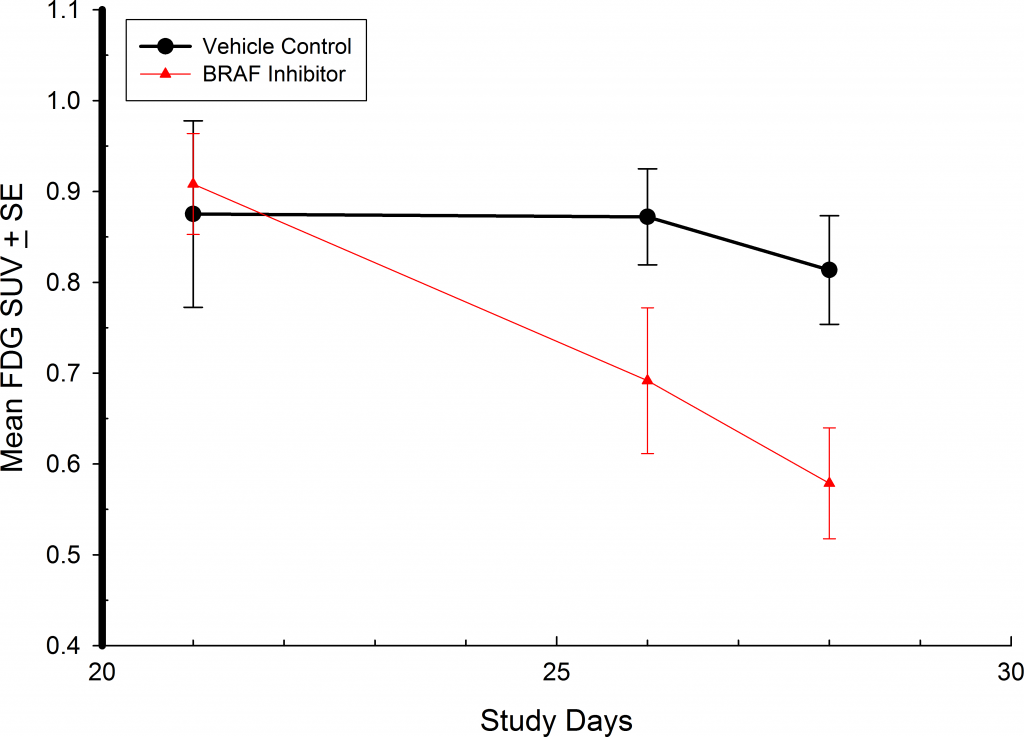Colo-205 as a translational imaging model for colorectal cancer
AUTHOR:
Chris Bull, Sr. Scientific Advisor, Imaging
DATE:
March 2017
As mentioned in ourHT-29 Model Spotlightlast October, colorectal cancer (CRC) is the second leading cause of cancer-related deaths in the United States for men and women combined. The death rate from CRC has been declining over the past several decades and there are now more than one million CRC survivors in the United States. However, there were still 95,000 new cases diagnosed in 2016.
Of these new CRC cases, about 10 percent of patients are characterized by a mutation in the B-Raf protooncogene serine/threonine kinase (BRAF) gene resulting in a valine-to-glutamate change at the residue 600 (V600E).1 BRAF is a known important player within the Mitogen-activated protein kinase (MAPK) pathway and known to have profound effects on cell growth, proliferation, and cell differentiation.2 Clinically, BRAF inhibitors have been shown to have remarkable ability to inhibit tumor metabolism as measured by 18F-deoxyglucose positron emission tomography (18FDG-PET).3
Table 1: Colorectal Cancer Models
At Covance we have a number of CRC models (see Table 1) and Colo-205 represents one of our most highly utilized lines with the BRAF mutation. We have also applied preclinical18FDG-PET to test translational applications. Figure 1 illustrates efficacy of a BRAF inhibitor against subcutaneous Colo-205 in nude mice. Colo-205 has also shown to be18FDG-PET avid and tumor metabolism modulation can be observed with BRAF treatment (Figures 2 and 3).



Contact Covanceto discuss your next preclinical CRC study design.
1Tejpar S, Bertagnolli M, Bosman F, et al. Prognostic and predictive biomarkers in resected colon cancer: current status and future perspectives for integrating genomics into biomarker discovery. Oncologist. 2010;15(4):390–404.
2Matallanas D, Birtwistle M, Romano D, et al. Raf family kinases: old dogs have learned new tricks. Genes Cancer. 2011;2(3):232–260.
3Marked, homogeneous, and early [18F]fluorodeoxyglucose-positron emission tomography responses to vemurafenib in BRAF-mutant advanced melanoma. J. Clin. Oncol. 30, 1628–1634 (2012).
Note: Studies were performed in accordance with applicable animal welfare regulations in an AAALAC-accredited facility
- Pan02-Luc: An orthotopic model of pancreatic cancer
- Bioluminescence imaging: In vivo monitoring of tumor development, disease dissemination and treatment efficacy
- 5TGM1-luc – A syngeneic murine model for multiple myeloma
- Functional Analysis of Tumor Infiltrating Lymphocytes by Flow Cytometry Using the Cytokine/Cytotoxicity™ Panel